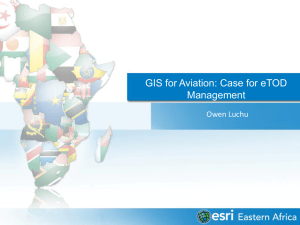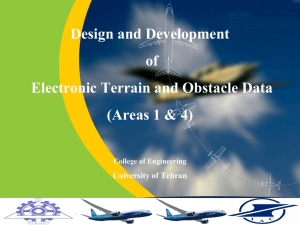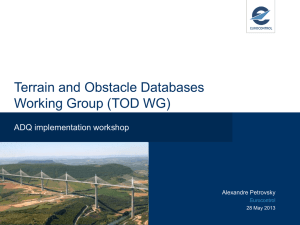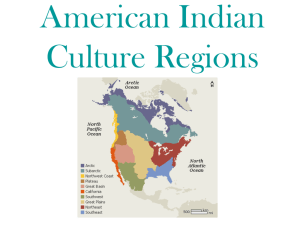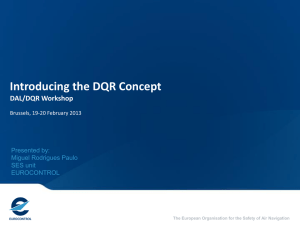eTOD Capture Areas
advertisement
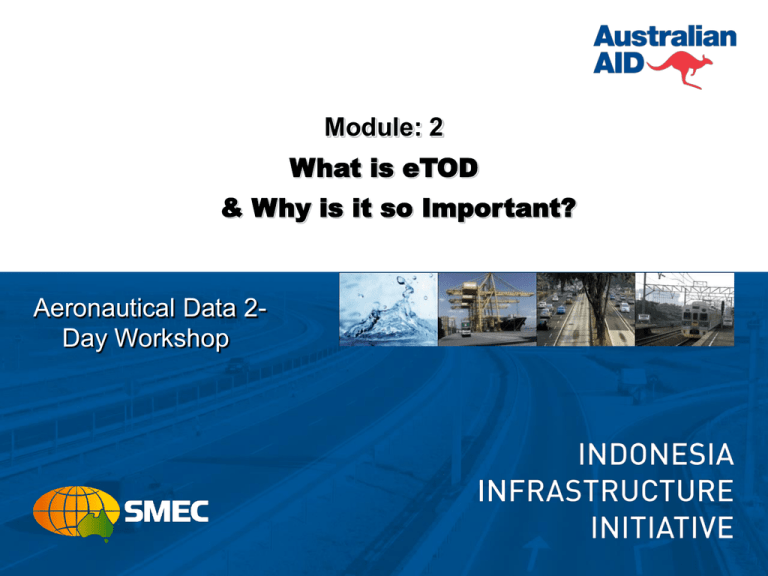
Module: 2 What is eTOD & Why is it so Important? Aeronautical Data 2Day Workshop Aeronautical Data 2-Day Workshop Module: 2 What is eTOD & Why is it so Important? November 2011 strategic airspace Objectives Understand reasons for eTOD Why What it is intended for? Be aware of related Aeronautical Data Requirements Be aware of eTOD status In terms of actual and potential applications In other regions and countries Understand issues in relation to good implementation Have sound overview of DGCA’s electronic terrain and obstacle data… and how well it conforms to eTOD requirements 3 Why is eTOD Happening? ICAO, FAA, EUROCONTROL, IATA, IFALPA, et al: CFIT continues to be major issue — and airborne systems can use such data, but need good data and standardised — hence incorporation of terrain data with obstacle data (refer DO276, App C-3, C.3) Increased push for improved systems for: Quality / Risk Management / Safety Management Industry pressure Improved safety Industry competitiveness (functionality advantages), and increasing capabilities) Standardisation (consistency) for wide-spread use by multiple applications (ground, airborne, data management, etc) 4 Why is eTOD Happening? Globalisation / Standardisation Logical extension of standardisation of other aeronautical data Eg, originally ARINC, now AIS->AIM. Eg, in Europe, EAD. Global standards, AICM/AIXM Applications that will use this kind of data will expect the data to conform to eTOD (Annex 15, RTCA DOs, etc) in future Data used/provided by all the different agencies and states around the world needs to be consistent so that It is able to be properly interpreted (data integrity); and It will be usable in a safe and consistent manner 5 Intended eTOD Data Uses Sum mary in RTCA Document, DO 276, Appendix C 6 Intended Uses Airborne Databases (ADBs) CNS/ATM Eg, ADSB / communications coverage Refer EUROCONTROL DEMETER for DME/DME Assessment Lots of “futures” They are still to be well defined and specified… But it takes a long time to develop such applications “Closest” real applications TAWS – eg, EGPWS (terrain only) Obstacles AND Terrain: Flight Procedures PANS-OPS Procedures: especially for RNAV, RNP, other semi and precision procedures and all PBN (note: may include departures in future) Engine-out procedures 7 Background to ICAO Standards Developed based on industry and ISO standards RTCA Docs 200A – Standards for Processing Aeronautical Data 201A – Standards for Aeronautical Information 276 – User Requirements for Terrain and Obstacle Data ISO 19000 Series for Geographic Information Derived from Open GIS Consortium (OGC) Key standards: o o o ISO 19113 (Quality Principles) ISO 19115 (Metadata) ISO 19131 (Data Product Specifications Aviation Standards for Aeronautical Data ICAO Annexes 4, 14, 15 ICAO Doc 9881 Guidelines for Electronic Terrain, Obstacle and Aerodrome Mapping Info and related FAA and European standards (based on above) 8 Basic Understanding of eTOD eTOD is specified in Annex 15 as having the following characteristics A set of minimum data quality requirements …for each of the geographic areas …defined for different applications; Metadata that should be captured and stored with eTOD data Two types of data: Obstacles; and Digital Terrain Models (DTMs) Terminology for Digital Terrain Data DTM (Digital Terrain Model) o DEM (Digital Elevation Model) o DTED (Digital Terrain Elevation Data) o 9 eTOD Capture Areas eTOD Capture Areas Source: Annex 15 10 eTOD Capture Areas Source: Annex 15 11 eTOD Capture Areas Source: Annex 15 12 eTOD Capture Areas Source: Annex 15 13 eTOD Status / Issues General Points Future applications: requirements still vague and not necessarily well understood Responsibilities & Cost Terrain Data Data volumes extreme, and costly, to capture and manage o o o o System capacity and management limitations How to use productively in existing systems Capture methods, timeliness Filtering? Management of change due to significant natural event (eg, earth quakes, volcanoes, landslides, tsunamis) 14 eTOD Status / Issues General Points Obstacle Data Cost implications are greatest, particularly with ICAO requirements for check and update cycles (1, 5 yrs) Handling of data between surveys (eg, proposals, approvals, construction, non-approved, temporary) Integration with Annex 14 (OLS) requirements ?! Management of change due to significant natural event. o Main potential implications are where geotechnical shift has caused displacement - laterally &/or vertically – of key features (eg, runway features) and obstacles * Note re significant events causing change eTOD: Link to SMS Requirement to check survey Potential NOTAMs, IFP Redesign &/or Revalidation Change Data Quality attributes in DB? 15 eTOD Status in Other Regions Some specific examples Australia not going to comply for ? years (unspecified) Regional Implementations EUROCONTROL eTOD Forum (http://www.eurocontrol.int/aim/public/standard_page/interop_tod_forum.html) attempts to simplify through 'interpretation' o One recent estimate of costs: EUR0 0.5m per airport for terrain survey in Area 2 o Some countries now have Areas 1 and 4 o Data volumes and management of data a big concern o AFeTOD - Africa - just starting Notice of differences where cannot comply Country-specific France, Spain, Egypt, etc Refer EUROCONTROL eTOD Forum Exchanges 16 eTOD in Indonesia? Sources and implementation of eTOD for Indonesia? Use of Publicly Available Terrain Data for Area 1? Management and consistency across different agencies? Same Meta data, same handling, same interpretation Ongoing maintenance and development of eTOD. Need maintenance system and specification, which incorporates processes for reviewing the maintenance system and the related specifications) System must include regular schedule for review, etc Ongoing surveys - more than Annex 14 requirements Process for incorporating data inbetween surveys (eg, approvals, temporary obstacles, unapproved obstacles, etc) Data improvement — include feedback to data supplier and getting controlled updates 17
